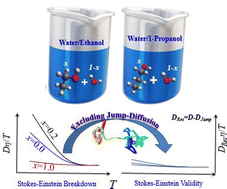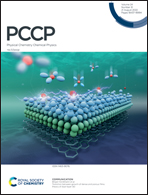Non-monotonic composition dependence of the breakdown of Stokes–Einstein relation for water in aqueous solutions of ethanol and 1-propanol: explanation using translational jump-diffusion approach†‡
Abstract
A series of experimental and simulation studies examined the validity of the Stokes–Einstein relationship (SER) of water in binary water/alcohol mixtures of different mixture compositions. These studies revealed a strong non-monotonic composition dependence of the SER with maxima at the specific alcohol mole fraction where the non-idealities of the thermodynamic and transport properties are observed. The translational jump-diffusion (TJD) approach elucidated the breakdown of the SER in pure supercooled water as caused by the jump translation of molecules. The breakdown of SER in the supercooled water/methanol binary mixture was successfully explained using the same TJD approach. To further generalize the picture, here we focus on the non-monotonic composition dependence of SER breakdown of water in two water/alcohol mixtures (water/ethanol and water/propanol) for a broad temperature range. In agreement with previous studies, maximum breakdown of SER is observed for the mixture with alcohol mole fraction x = 0.2. Diffusion of the water molecules at the maximum SER breakdown point is largely contributed by jump-diffusion. The residual-diffusion, obtained by subtracting the jump-diffusion from the total diffusion, approximately follows the SER for different compositions and temperatures. We also performed hydrogen (H-)bond dynamics and observed that the contribution of jump-diffusion is proportional to the total free energy of activation of breaking all H-bonds that exist around a molecule. This study, therefore, suggests that the more a molecule is trapped by H-bonding, the more likely it is to diffuse through the jump-diffusion mechanism, eventually leading to an increasing degree of SER breakdown.



 Please wait while we load your content...
Please wait while we load your content...